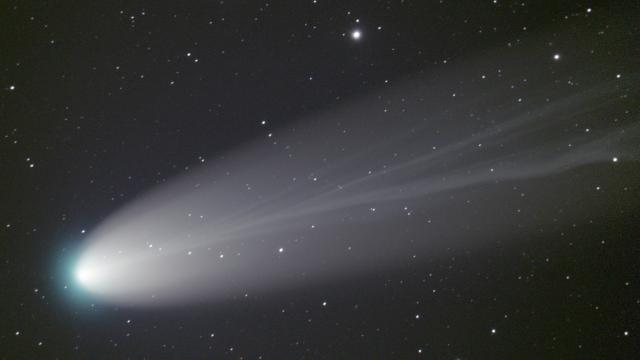Leonard will not be making its next 80,000-year-long journey around the Sun, as the mile-wide comet appears to have disintegrated in late February.
Astronomer Gregory Leonard from the Catalina Sky Survey was the first human to spot the comet, which he did on January 3, 2021, a year before its perihelion on January 2, 2022. This closest approach to the Sun proved to be Leonard’s undoing, as all signs point to the demise of this dirty snowball — the brightest of the previous year.
“It is now moving away from the Sun and has not only faded but is now missing its two most important parts: its nucleus (core) and its coma (the nebulous envelope surrounding the nucleus, which appears when a comet passes near the sun),” EarthSky reports.
At perihelion, Leonard, also known as Comet C/2021 A1, came to within 56 million miles (90 million kilometers) of the Sun. By comparison, Earth during perihelion comes to within 91 million miles (147 million km) of the star. The Sun’s warmth brought Leonard to life, causing it to release gas and dust, but the comet’s sojourn through the inner solar system turned out to be its undoing.
Scientists were able to study Leonard using the Solar Terrestrial Relations Observatory-A (STEREO-A), operated by NASA, and Solar Orbiter, a joint project of NASA and ESA. Comets tend to be like snowflakes, as no two are alike in terms of their behaviour, and they’re virtually impossible to predict.
When Gregory Leonard first observed the comet, it was still way out near the orbit of Jupiter. Speculation emerged that it might become visible to the unaided eye as it got closer, but this turned out not to be the case, as the comet could only be seen with telescopes and binoculars. And like any comet cruising for a solar flyby, Leonard was at risk of disintegrating, a possibility that appears to have transpired. The 2 km-wide (1.6-km) comet, which had just barely started its 40,0000-year return journey to the outer solar system, seems to have fizzled out.
Astronomers began to notice the signs of the comet’s doom around the time of its perihelion. These included fluctuations in its brightness every three to five days and wonky structural changes in its tail — a potential signal that chunks were falling off the nucleus, according to EarthSky. On February 23, 2022, astronomer Martin Mašek from the Institute of Physics at the Czech Academy of Sciences found that Leonard, which could only be seen in the southern hemisphere, had become a fading streak in space, without a glowing head. Mašek conducted remote observations from an observatory in Chile.
The most likely scenario is that the nucleus disintegrated or evaporated, or a combination of the two. Regardless, Leonard will go down in history as the brightest comet of 2021. It’s sad to lose a fellow traveller, but comets do appear in the sky with decent regularity. There’s bound to be another one soon, and the next one may even be visible to the naked eye.
